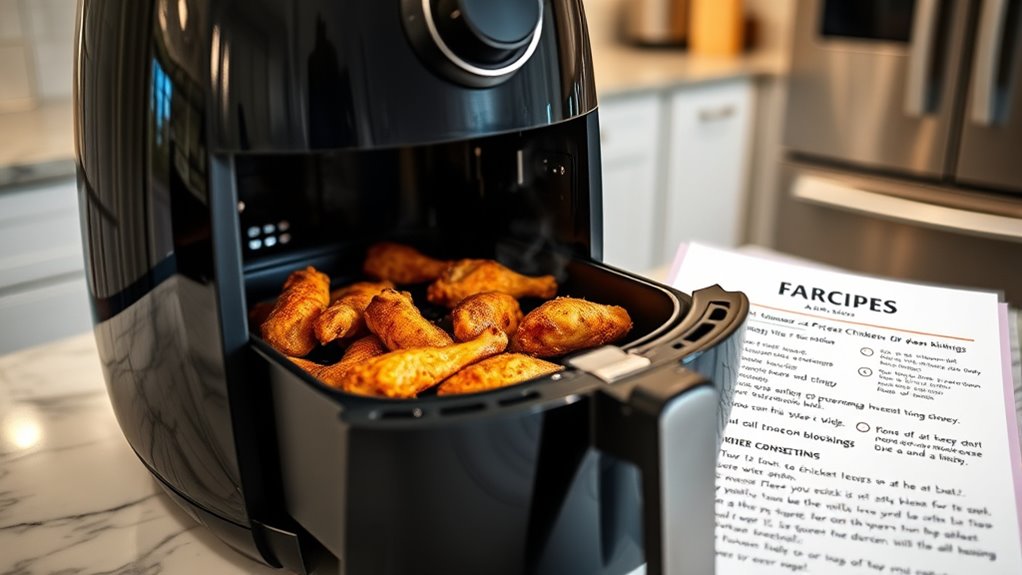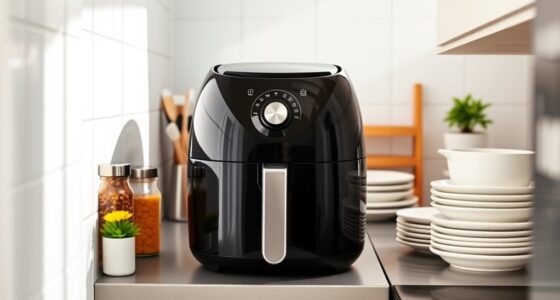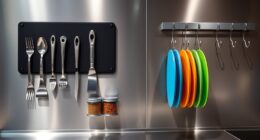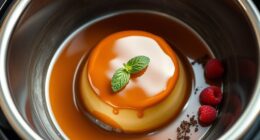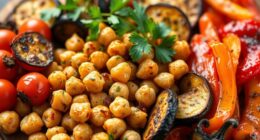To convert oven recipes to air fryer settings, start by lowering the temperature by about 25°F since air fryers cook hotter. Cut the cooking time by a few minutes and check your food early to prevent overcooking. Arrange ingredients in a single layer for even crispiness, and consider adding a little extra seasoning for flavor concentration. Keep experimenting with these adjustments, and you’ll discover how simple it is to achieve perfect results—more tips ahead to help you get it just right.
Key Takeaways
- Reduce the oven temperature by about 25°F to prevent burning due to rapid air circulation.
- Cut down the cooking time and check food early to avoid overcooking.
- Avoid overcrowding the basket and space out ingredients for even crispiness.
- Lightly oil or spray food to enhance browning and flavor.
- Keep notes on adjustments and experiment to optimize results for your specific air fryer model.
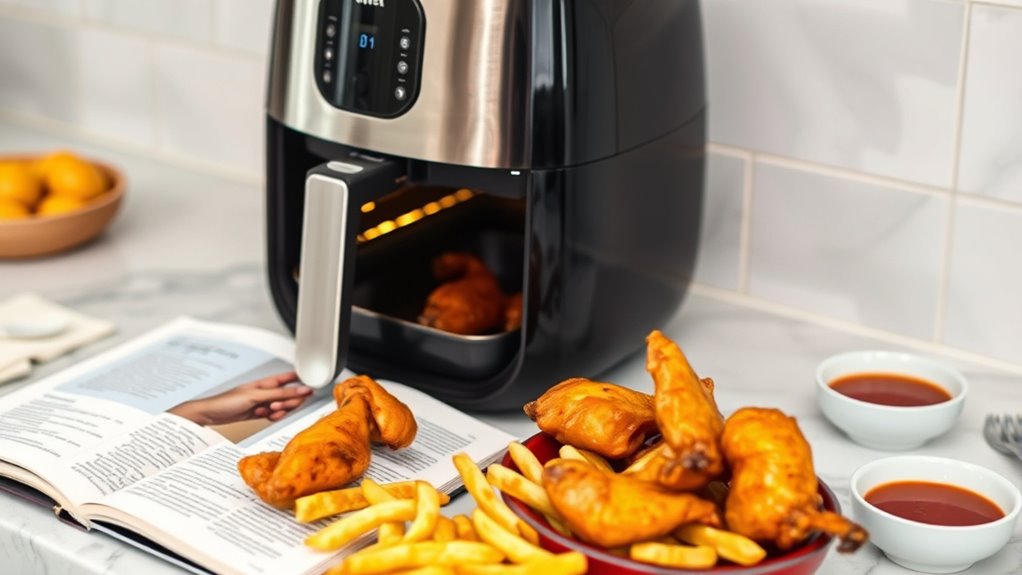
If you’re used to oven recipes, switching to an air fryer can seem challenging at first, but it’s actually quite straightforward. The key is understanding that air fryers cook faster and more efficiently due to their compact size and rapid air circulation. To adapt your favorite oven recipes, start by reducing the temperature. A good rule of thumb is to cut the oven temperature by about 25°F, since air fryers tend to cook hotter. For example, if your oven recipe calls for 400°F, set your air fryer to 375°F.
Reduce oven temperatures by about 25°F when converting recipes for your air fryer.
Next, consider the cooking time. Because of the increased heat transfer, your dish will typically cook in less time. Keep a close eye on your food, checking it a few minutes earlier than the oven instructions suggest. For most items, start checking around the halfway point of the expected cooking time and adjust as needed. This helps prevent overcooking or burning, especially since air fryers can crisp up food quickly.
When it comes to baking tips, remember that the air fryer’s basket or tray allows for better air flow around your food, leading to a crispier exterior. To optimize results, avoid overcrowding the basket. Providing space ensures hot air can circulate freely, giving you an evenly cooked, crispy outcome similar to oven baking but faster. If you’re baking something like cookies or small pastries, you might need to adjust the batter or dough thickness slightly because thinner or more spread-out items tend to crisp more evenly.
Seasoning adjustments are equally important. Because air fryers often concentrate heat and airflow directly on the surface, flavors can intensify or change. For instance, if your oven recipe calls for a long bake, you might want to tweak seasonings—adding a touch more salt, herbs, or spices—to compensate for the intensified heat and flavor concentration. Also, lightly oiling or spraying your food before air frying helps with browning and seasoning adherence, enhancing flavor and texture.
Additionally, understanding the performance metrics of your air fryer, such as maximum pressure and spray pattern, can help you better replicate oven results and optimize your cooking process. Finally, don’t be afraid to experiment. Every air fryer model varies slightly, so keep notes of your adjustments—temperature, time, seasoning—to refine your process. Once you get the hang of it, converting oven recipes becomes a quick, enjoyable way to enjoy your favorites with less time and less fuss. With these tips, baking adjustments, and seasoning tweaks, you’ll find that your air fryer can become an indispensable tool for cooking delicious, crispy meals that rival or surpass traditional oven results.
Frequently Asked Questions
Can I Use the Same Cookware in the Air Fryer as in the Oven?
You might wonder if your existing oven cookware works in the air fryer. Not all air fryer cookware is oven compatible, so check the manufacturer’s details before using it. Use heat-safe materials like metal, silicone, or certain plastics designed for high temperatures. Avoid glass or non-oven-safe plastics, as they can crack or melt. Always make certain your air fryer cookware fits properly and doesn’t block airflow for ideal cooking.
How Do I Adjust Cooking Times for Different Types of Recipes?
When adjusting cooking times for different recipe variations in your air fryer, start by reducing the oven time by about 20-25%, as air fryers cook faster. Keep an eye on your food and check frequently to prevent overcooking. For delicate items, reduce time even further. Remember, each recipe is unique, so you may need to make small adjustments with practice to find the perfect cooking time for your specific dish.
Is It Safe to Stack Food in the Air Fryer?
You might think stacking food in the air fryer is a tiny thing, but it can totally mess with the magic of air circulation. When you layer food, it blocks hot air from reaching all surfaces, risking uneven cooking. To keep your meals crispy and perfectly cooked, avoid excessive food layering. Instead, spread out your ingredients, ensuring proper air flow and safe, delicious results every time.
How Do I Prevent Food From Sticking or Burning?
To prevent food from sticking or burning, start by lightly spraying your basket with non-stick sprays or lining it with parchment paper. This creates a barrier that reduces sticking and makes cleanup easier. Keep an eye on your food as it cooks, and shake or turn it halfway through to promote even browning. These simple steps help you achieve crispy, perfectly cooked results without mess or burning.
Are There Recipes That Don’T Convert Well to the Air Fryer?
Imagine your air fryer as a modern-day squire, ready to take on recipes. Some dishes, due to recipe incompatibility or texture issues, simply don’t translate well. Thick batters, delicate baked goods, or recipes requiring slow cooking often lose their magic in the air fryer. You’ll find that certain recipes don’t convert well, and trying to force them can result in disappointing texture or uneven cooking. Know your limits, and experiment carefully!
Conclusion
Switching from oven to air fryer isn’t just about adjusting time and temperature; it’s about embracing a new way to cook that can actually enhance flavors and textures. Some say air fryers create a “crisping” effect that’s impossible in traditional ovens, and recent studies suggest they can even preserve nutrients better. So, experiment confidently—your favorite recipes might turn out even better, proving that sometimes, a simple change in method can lead to surprisingly delicious results.
